So you want to know about all the different kinds of sea turtles, huh? Well, you’ve come to the right place! Get ready to become a sea turtle expert.
There are seven types of sea turtles that swim through our oceans. That’s right – seven! Here we will dish all the deets on these magnificent marine reptiles. Let’s do this!
1. The Graceful Green Sea Turtle
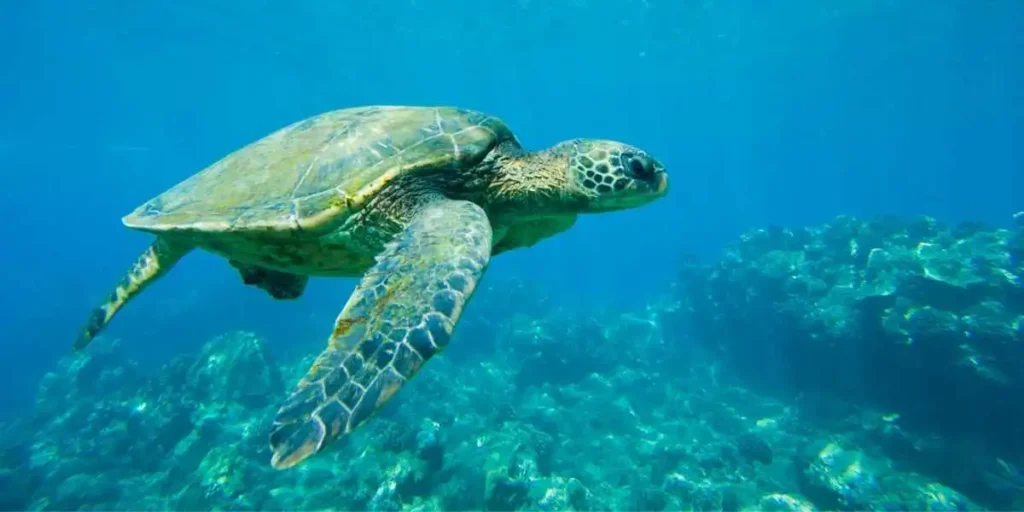
First up we have the green sea turtle. These green machines are named for the greenish color of their fat and cartilage – very appetizing, I know!
Green sea turtles are found cruising around in tropical and subtropical waters worldwide. They migrate long distances between their feeding grounds and the beaches where they nest.
Now, the green sea turtle has a very refined palate. They enjoy munching on seagrasses and algae. No jellyfish or squid for this turtle! Just the healthy greens for Mr. Green.
The green sea turtle is a straight up vegetarian. They spend their days peacefully grazing on seagrass beds like a bunch of underwater cows. Moo!
These mellow turtles can grow up to 5 feet long and weigh over 300 pounds! Even though they are massive, the green sea turtle moves through the water with beautiful grace. Hence, the name!
Green sea turtles have lovely smooth shells that range from gray to black in color with radiating stripes. Their undersides are white or light yellow.
Unfortunately, the green sea turtle is an endangered species. They are threatened by pollution, habitat loss, fishing nets, and those jerks that steal their eggs. We must protect this graceful swimmer!
2. The Ancient Loggerhead

Next we have the loggerhead sea turtle. Awesome name, right? Makes me think of a turtle with a giant log for a head!
Well, loggerhead turtles don’t actually have log-shaped heads. But they do have big heads – about the size of a coconut. Their heads are reddish-brown in color.
Loggerheads are found worldwide in tropical and subtropical waters – basically paradise! These turtles go on long migrations across the oceans between their feeding and breeding grounds.
The loggerhead has a much more diverse diet than the picky green turtle. Loggerheads are omnivores, feasting on animals like mollusks, crustaceans, sea urchins, jellyfish, fish, and even dead animals. Yum!
An adult loggerhead can grow over 3 feet long and exceed 300 pounds. Their shells are a lovely red-brown color.
Loggerhead sea turtles have existed for around 110 million years! Can you believe how ancient these creatures are? The dinosaurs didn’t even live that long!
But today the loggerhead is classified as a vulnerable species. Like most sea turtles, they are threatened by pollution, fishing, habitat destruction, and climate change. We must protect these ancient mariners!
3. Leatherback – Largest of them All
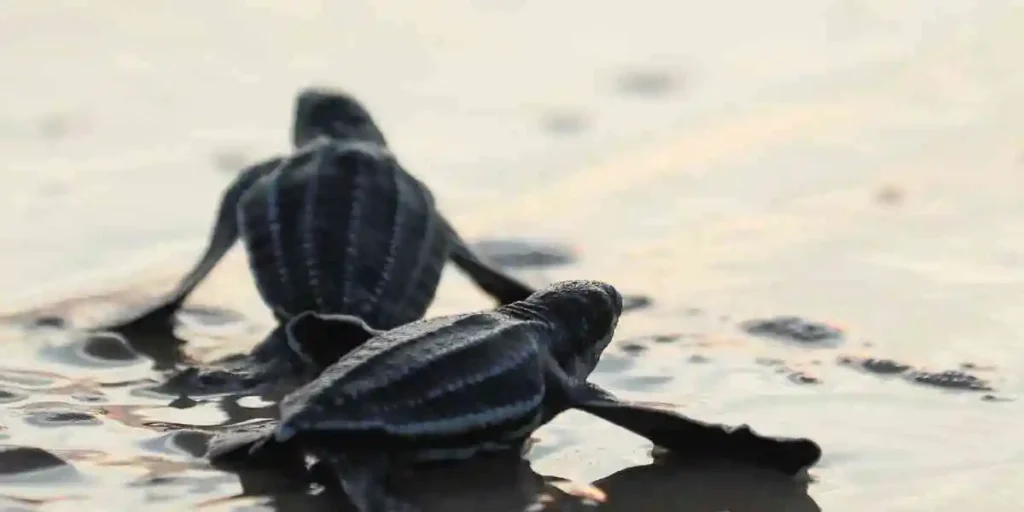
Now we come to the leatherback sea turtle – and this ancient animal is impressive!
The leatherback is the largest sea turtle and also the deepest diver, known to descend over 3000 freaking feet into the ocean – that’s deeper than the Empire State Building is tall!
Leatherbacks migrate further than any other sea turtle, cruising all over the world’s oceans. They especially love the cold waters of Canada, Alaska, and Norway. Brrrr!
Now leatherbacks have a mostly jellyfish diet. Their favorite is the dangerous Portuguese Man O’ War. Leatherbacks have tough skin and fat to protect them from the jellyfish stings. Nice trick!
Leatherbacks don’t have a hard shell like other turtles. Instead, their shell is leathery and rubbery. That’s why they are called leatherbacks!
These gigantic turtles can grow over 6 feet long and weigh about 2000 pounds. That’s heavier than a grand piano!
Leatherbacks make epic migrations of over 10,000 miles each year. Unfortunately they face many threats on their journeys, including plastic pollution. These amazing giants are critically endangered.
4. Hawksbill – The Tropical Treasure
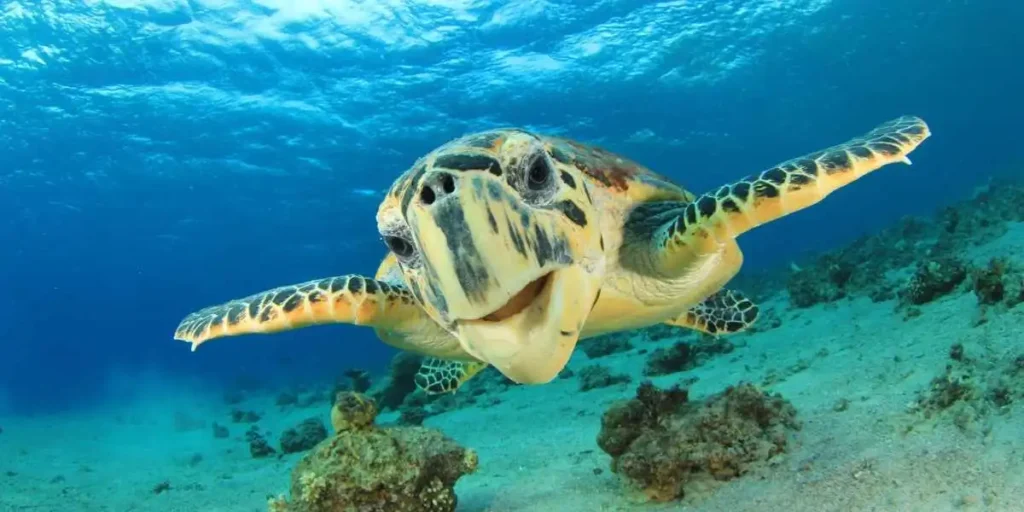
Say hello to the beautiful hawksbill sea turtle! Hawksbills are easy to identify from their coloring and super sharp beak.
Hawksbills live in tropical waters around the world, often near coral reefs. They migrate between nesting beaches and feeding grounds.
The hawksbill’s shell is absolutely gorgeous – it has amber and brown markings that form a lovely pattern. Each one is unique like a fingerprint!
These turtles use their narrow pointed beaks to pry tasty sponges and other critters from the reef. They also munch on anemones and squid.
An adult hawksbill can grow around 3 feet long and weigh up to 200 pounds. Not as huge as other turtles, but still impressive!
Unfortunately Hawksbill sea turtle populations have decreased by about 80% in the last century due to hunting and habitat loss. This fancy turtle is critically endangered.
5. Ridley – Master of Mass Nesting
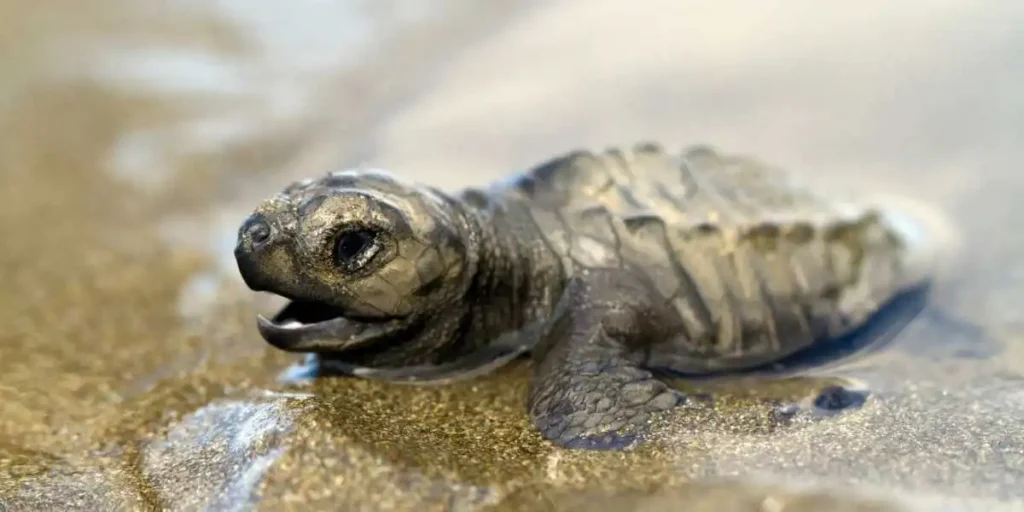
Moving on we have the olive ridley sea turtle. As you may have guessed, they are named for their olive green-colored shell. Pretty!
Olives live in warm tropical waters worldwide, but are most abundant along the Pacific coast of Mexico and Costa Rica. Party time!
Now olive ridleys are best known for their synchronized, large scale nesting events called arribadas.
During an arribada, thousands of female ridleys come ashore all at once to lay their eggs on the same beach! It’s a sea turtle MASSIVE NESTING PARTY!
The arribadas happen around the same time each year shortly after a full moon. No one knows exactly how the turtles coordinate this – it’s a mystery!
Olive ridleys are smaller than many turtles, growing around 2 feet long. They have an omnivorous appetite, eating crabs, shrimp, snails, jellyfish, and algae.
Though amazing, olive ridley populations have declined at least 50% from hunting and fishing. They are currently vulnerable to extinction. Bummer.
6. Kemp’s Ridley – Smallest of Them All

The smallest and most endangered sea turtle is the Kemp’s ridley. These little guys are seriously at risk.
Adult Kemp’s ridleys grow to about 2 feet long – no bigger than a large pizza! Their shells are grey-olive with a yellow-white underside.
These tiny turtles mostly live in the Gulf of Mexico and along the Atlantic coast of the U.S. They do not migrate across oceans like other species.
Kemp’s ridleys have an omnivorous appetite for crabs, shrimp, snails, jellyfish, mollusks, fish, and even some seaweed.
Here’s a crazy fact – in 1947 a single film documented over 40,000 females nesting in one day! Can you imagine?
But soon after, their numbers crashed from extensive egg collecting and hunting. Today the Kemp’s ridley is critically endangered and at high risk of extinction.
We must do everything we can to save these precious little sea pancakes! I mean, sea turtles.
7. Flatback – Australia’s Turtl
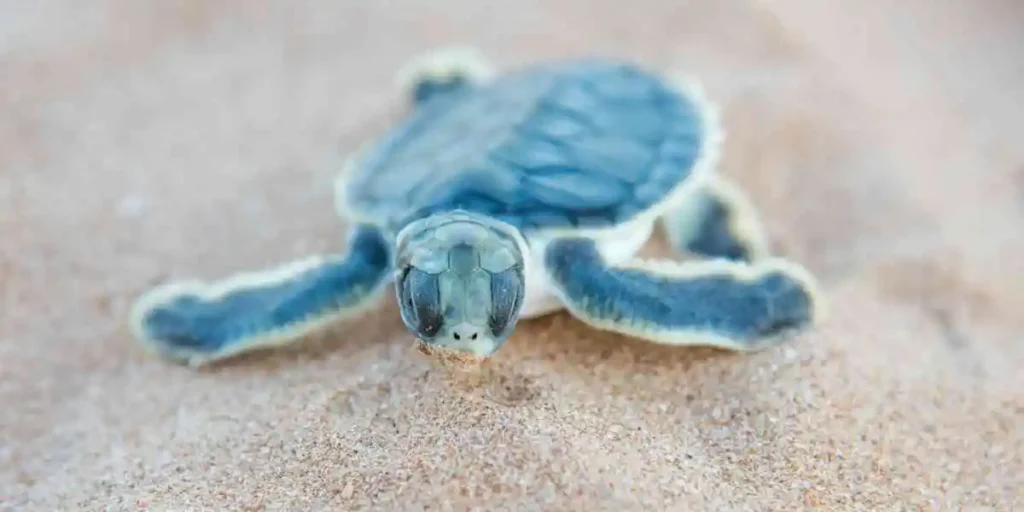
Last but not least, we have the eccentric flatback sea turtle! This funny guy only lives in the waters around northern Australia and southern New Guinea.
As you may have guessed from the name, the flatback has a flattened, smooth carapace that makes it look kind of pancaked. Adorbz.
They don’t migrate long distances like other turtles, preferring to stick close to home along the continental shelf. Can’t blame them – Australia is beautiful!
Flatbacks grow up to about 3 feet long and have a primarily sea cucumber diet. But they also munch on soft corals, shrimp, squid, and jellyfish.
Unlike other sea turtles, flatbacks have never been hunted for their meat, shells, or eggs. But they still face threats from pollution and habitat loss.
Their global numbers are uncertain, so flatbacks are currently data deficient when it comes to conservation status. More research is needed to protect this Aussie turtle!
Conclusion
So there you have it – the magnificent seven species of sea turtle! From the massive leatherback to the tiny Kemp’s ridley, each turtle is equally awesome.
Sea turtles are truly ancient creatures that have been swimming the oceans for over 100 million years! I mean, they were around when the dinosaurs roamed. Incredible!
Sadly today most sea turtles species are endangered or critically endangered due to human activities like hunting, fishing, and pollution.
But we have the power to protect these incredible creatures so future generations can enjoy their grace, beauty, and epic underwater adventures! It’s turtle time!
Hope you are now a sea turtle expert and fall in love with these amazing shelled swimmers like I have. Cowabunga dudes!
